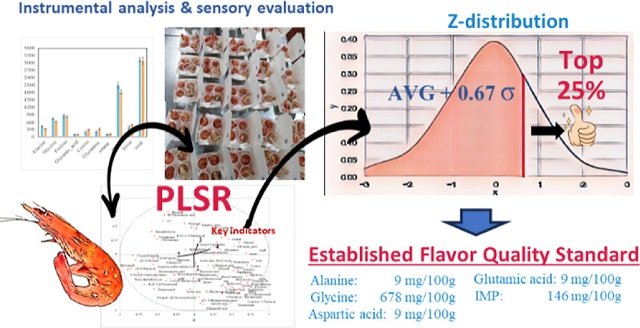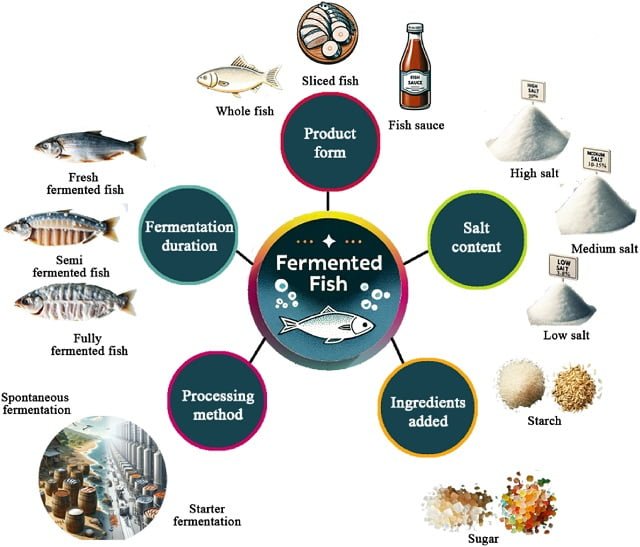
Dried shrimp on shelves often face a challenge: the development of ammonia-like off-flavors (ALOF) during storage. This unpleasant flavor can significantly affect product quality and consumer acceptance.
While previous studies have identified dried shrimp’s susceptibility to ALOF, the precise mechanisms behind their formation have remained somewhat elusive. A study published in the journal Food Chemistry by scientists from Zhejiang University of Technology aimed to shed light on this issue by investigating the contribution of different parts of dried shrimp to ALOF and characterizing the formation mechanisms from the perspectives of microbial spoilage and amino acid metabolism.
- 1 The Role of Shrimp Anatomy
- 2 The Complexities of ALOF Formation
- 3 Microbial Influence and Amino Acid Metabolism
- 4 A New Study Sheds Light
- 5 The Role of Head Viscera
- 6 Microbial Spoilage
- 7 Amino Acid Metabolism
- 8 Sensory Scores and Off-Flavor Indicators
- 9 Implications for Storage and Quality Control
- 10 Conclusion
- 11 Entradas relacionadas:
The Role of Shrimp Anatomy
Various parts of the shrimp’s body contribute to flavor development. The head, in particular, has been identified as a source of strong aroma. Studies have highlighted the presence of compounds such as pyrazines, thiazolines, and thiazoles, which originate in the shell and viscera, contributing to the distinctive flavor profile of dried shrimp. However, the precise source of these flavor components remains a topic of debate, as volatile compounds alone may not provide a definitive answer.
The Complexities of ALOF Formation
ALOF in dried shrimp results from a combination of factors, including shrimp body composition, storage conditions, and microbial activity. The head and viscera of shrimp have been identified as significant contributors to flavor formation, and pyrazines, thiazolines, and thiazoles originating from the shells or viscera of shrimp play a crucial role in shaping the distinctive aromatic profile.
Microbial Influence and Amino Acid Metabolism
Microorganisms play a fundamental role in the spoilage of dried shrimp. They break down proteins, leading to the formation of peptides and amino acids. These amino acids can undergo further decomposition, resulting in the production of biogenic amines (BA), ammonia, urea, and volatile compounds.
Deamination and decarboxylation processes, catalyzed by spoilage bacteria, are crucial in this breakdown. Deamination provides essential carbon skeletons for bacterial metabolism, while decarboxylation leads to the production of BA, which contribute to unpleasant flavors.
A New Study Sheds Light
To better understand the microbial degradation mechanisms associated with dried shrimp, the researchers conducted a comprehensive study aimed at uncovering the root causes of ALOF in dried shrimp. The researchers divided the shrimp into different parts, processed them, and monitored changes in various parameters during storage.
The parameters included sensory analysis, electronic nose analysis, total viable counts, total volatile basic nitrogen, ammonia, urea, biogenic amines, and amino acid deamidation and decarboxylation activities.
The Role of Head Viscera
The head viscera, which serve as the shrimp’s first line of defense, are rich in nutrients and can provide a breeding ground for microorganisms after the shrimp’s death. However, the specific effects of these viscera on the quality of dried shrimp and spoilage during storage remain unclear.
Stay Always Informed
Join our communities to instantly receive the most important news, reports, and analysis from the aquaculture industry.
The study revealed that the head viscera, specifically the internal organs located within the head, are the main contributors to ALOF. These organs, rich in nutrients and capable of harboring microorganisms, create a favorable environment for the development of unpleasant flavors.
Microbial Spoilage
Microorganisms play a significant role in the spoilage of dried shrimp, breaking down proteins and resulting in the formation of peptides and amino acids. Amino acids can further decompose into a variety of substances, including biogenic amines (BA), ammonia, urea, and volatile compounds. Deamination and decarboxylation of amino acids by microorganisms are crucial in the spoilage of aquatic products, as they provide essential carbon skeletons for spoilage bacteria to use in energy metabolism and material synthesis.
Bacteria present in the head viscera were identified as the primary source of microorganisms in stored dried shrimp. These bacteria play a crucial role in promoting protein degradation and amino acid metabolism, ultimately leading to the formation of ALOF.
Amino Acid Metabolism
The breakdown of amino acids facilitates microbial growth while also degrading the quality of dried shrimp. The breakdown of urea and amino acids leads to higher levels of ammonia and unpleasant odors in dried shrimp, resulting in the deterioration of quality. Decarboxylation is another amino acid degradation method triggered by spoilage bacteria, resulting in the production of corresponding types of BA. Among the BA, putrescine (Put) and cadaverine (Cad) produce unpleasant flavors in seafood.
The study discovered that both the deamination and decarboxylation activities of spoilage microbiota contribute to ALOF formation. Deamination, the process of removing an amino group from an amino acid, is particularly prominent in the case of bitter amino acids. This suggests that the bitter taste associated with ALOF is likely due to the breakdown of these specific amino acids.
Sensory Scores and Off-Flavor Indicators
The researchers also evaluated the sensory scores of dried shrimp products with and without head viscera during storage. The results showed that the groups without head viscera maintained at 0-1°C during storage had no detectable ammonia odor, indicating that the removal of head viscera can significantly reduce the likelihood of ALOF development.
Implications for Storage and Quality Control
The findings of this study provide valuable insights into the key contributors to ALOF formation in dried shrimp and the underlying mechanisms behind their formation. By removing head viscera during processing and controlling the growth of visceral bacteria, manufacturers can significantly reduce the risk of ALOF development in dried shrimp products.
Furthermore, the study results highlight the importance of proper storage conditions, such as maintaining a temperature of 0-1°C, to prevent spoilage microbiota growth and minimize ALOF formation.
Conclusion
In conclusion, ALOF in dried shrimp is a complex issue, influenced by a combination of factors including shrimp body composition, storage conditions, and microbial activity. The head and viscera of shrimp have been identified as major contributors to flavor formation, and microorganisms play a crucial role in the spoilage of dried shrimp. The breakdown of amino acids facilitates microbial growth while simultaneously degrading the quality of dried shrimp.
Further research is needed to fully understand the mechanisms underlying ALOF formation in dried shrimp and to develop effective strategies for controlling ALOF generation and ensuring the quality and acceptability of dried shrimp products.
The study was funded by the National Key Research and Development Program of China and the Zhejiang Province Sannong Jiufang Science and Technology Cooperation Program.
Contact
Xuxia Zhou
Key Laboratory of Marine Fishery Resources Exploitment & Utilization of Zhejiang Province, National R&D Branch Center for Pelagic Aquatic Products Processing (Hangzhou), College of Food Science and Technology, Zhejiang University of Technology
Hangzhou 310014, Zhejiang, China
Email: xzhou@zjut.edu.cn
Reference (open access)
Bai, Y., Wang, M., Zhang, X., Ke, Z., Zhu, S., Ding, Y., & Zhou, X. (2024). Mechanisms of ammonia-like off-flavors formation in dried shrimp: Contribution of spoilage microbiota and their metabolism. Food Chemistry, 141445. https://doi.org/10.1016/j.foodchem.2024.141445
Editor at the digital magazine AquaHoy. He holds a degree in Aquaculture Biology from the National University of Santa (UNS) and a Master’s degree in Science and Innovation Management from the Polytechnic University of Valencia, with postgraduate diplomas in Business Innovation and Innovation Management. He possesses extensive experience in the aquaculture and fisheries sector, having led the Fisheries Innovation Unit of the National Program for Innovation in Fisheries and Aquaculture (PNIPA). He has served as a senior consultant in technology watch, an innovation project formulator and advisor, and a lecturer at UNS. He is a member of the Peruvian College of Biologists and was recognized by the World Aquaculture Society (WAS) in 2016 for his contribution to aquaculture.




